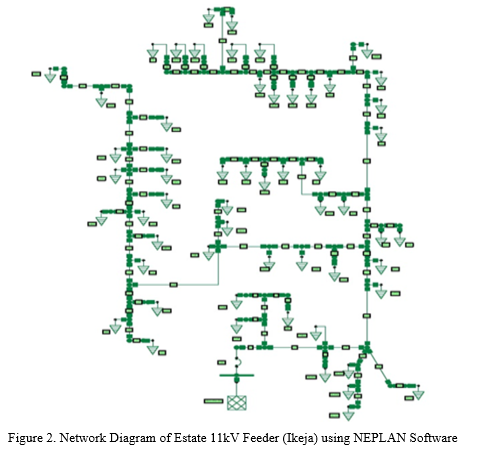Natural Phenomena-Induced Electrical Faults Impacts in the Distribution System of Lagos
Keywords:
ELECTRICAL FAULTS, NATURAL PHENOMENA, IMPACTS, DISTRIBUTION SYSTEM, FEEDERSAbstract
This study assessed the impacts of natural phenomena-induced electrical faults on the distribution system of Lagos, served by Ikeja and Eko electricity distribution companies. The research evaluated the frequency, technical, cost, and reliability impacts of these faults. The study employed statistical and software-based short circuit fault analyses as well as system reliability indices methods to identify the most vulnerable feeders to nature-induced faults. It also simulated the network's response to fault currents and estimated the monthly costs of nature-induced outages. For the data period, an average of 20 to 43 nature-induced faults occurred annually on the networks. The obtained fault currents ranged from 0.67kA to 0.78kA and 0.52kA to 1.02kA for the 11kV and 33kV networks, respectively, which was useful for setting up installed breakers. The estimated average monthly cost of nature-induced energy loss was found to be between ?3 million and ?143 million for Eko and between ?0.01 million and ?108 million for Ikeja. The System Average Interruption Frequency Index and System Average Interruption Duration Index did not exceed 4 and 60, respectively, on 33kV network. In conclusion, natural phenomena-induced electrical faults had significant impacts, particularly in terms of monthly costs and investments in its mitigation should be explored.
Downloads
References
A. U. Adoghe, et al., “Performance Evaluation of the Prospects and Challenges of Effective Power Generation and Distribution in Nigeria,” Heliyon, Vol. 9, pp. 1-2, 2023.
FGN, “Federal Republic of Nigeria Official Gazette – Legal Notice on Publication of 2006 Census Final Results,” The Federal Government Printer, Abuja, Nigeria FGP16/22009/10,000(OL02), vol. 96, B3, 2009.
G. N. Okeke, “The Nigeria Perspective of Global Climate Change: A Case Study of Coastal Areas of Lagos,” Open Journals of Environmental Research, vol. 3, pp. 42-43, 2020
L. Olurode, et al., “Urbanisation and Energy Crisis: The Case of Lagos State,” Sociology and Anthropology, vol. 6, pp. 845-853, 2018.
O. O. Mohammed, et al., “The Challenges and Panaceas to Power Distribution Losses in Nigeria,” Arid Zone Journal of Engineering, Technology & Environment, vol. 16, pp. 121-122, 2019
M. Waseem and S. D. Manshadi, “Electricity Grid Resilience amid Various Natural Disasters: Challenges and
Solutions,” The Electricity Journal, vol. 33, pp. 1-7, 2020
H. H. Alhelou, et al., “A Survey on Power System Blackout and Cascading Events: Research Motivations and Challenges,” Energies, vol. 12, pp. 12-13, 2019.
P. S. Ayobo, et al., “Electric Power Faults Evaluation On 33KV Distribution Network,” Iconic Research and Engineering Journals, vol. 4, pp. 24, 2020.
R. J. Campbell, “Weather Related Power Outages and Electric System Resiliency,” 2012 Congressional Research Service Report for U.S. Congress, pp. 2, 2012.
B. Oral and F. Donmez, “The Impacts of Natural Disasters on Power Systems: Anatomy of the Marmara Earthquake Blackout,” Acta PolytechnicaHungarica, vol. 7, pp. 107–118, 2010.
] N. Gunduz, et al., “Impacts of Natural Disasters on Swedish Power Policy: A Case Study,” Sustainability, vol. 9, pp. 1-11, 2017.
P. L. Watson, et al., “Improved Quantitative Prediction of Power Outages Caused by Extreme Weather Events,” Weather and Climate Extremes, vol. 37, pp. 1, 2020.
M. S. S Fogliatto, et al., “Power Distribution System Interruption Duration Model Using Reliability Analysis Regression,” Electric Power Systems Research, vol. 211, pp. 1, 2022.
S. Ross, “Introduction To Probability and Statistics For Engineers and Scientist,” London: Elsevier Academic Press, pp. 9-22, 2009.
J. B. Gupta, “A Course in Electrical Power,” 14th ed. India: S.K. Kataria & Sons, Delhi, pp. 22-23, 40, 588-595, 2005.
J. D. Glover, et al., “Power System Analysis,” 4th ed. USA: Cengage Learning, USA, pp. 446-448, 2007.
Nazaruddin, et al., “Reliability Analysis of 20 KV Electric Power Distribution System,” in IOP Conference Series: Materials Science and Engineering, 2020. Second International Conference on Science and Innovated Engineering, pp. 4-5, 2020.
O. A. Quiroga, et al., “Fault Causes Analysis in Feeders of Power Distribution Networks,” in International Conference on Renewable Energies and Power Quality, 2011. ICREPQ 2011. EA4EPQ, pp 1269-1271, 2011.
L. Wang, “The Fault Causes of Overhead Lines in Distribution Network,” in MATEC Web of Conferences, 2016. APOP2016. MATEC Web of Conferences Sixty-one, pp 1-4, 2016.
G. H. Kjolle, “What do Fault Statistics tell us regarding causes resulting in Power Outages?” in Workshop DNV – NTNU Risk and Vulnerabilities in Power Systems in light of climate changes, 2011. NTNU2011. SINTEF, pp 1 – 32, 2011.
R. Ali, et al., “Financial Hazard Prediction due to Power Outages Associated with Severe weather-related natural disasters Categories,” Energies, vol. 15, pp 7, 2022.
Y. Tan, A.K. Das, P. Arabshahi and D.S. Kirschen, “Distribution Systems Hardening Against Natural Disasters,” arXiv:1711.02205v1 [math.OC], Nov 6, 2017, pp 1, 2017.
H. Chen, et al., “Assessing the business interruption costs from power outages in China,” Energy Economics, vol. 105, pp 5, 2022.
N. Gunduz, et al., “Impacts of Natural Disasters on Swedish Power Policy: A Case Study,” Sustainability., vol. 9, pp 1 -11, 2017.
D. A. Folarin, et al., “Appraisal of Electric Power Distribution Feeders Reliability in the Region unit in Nigeria,” International Journal of Engineering Research and Technology, vol. 6, pp 99, 2017.

Downloads
Published
How to Cite
Issue
Section
ARK
License
Copyright (c) 2024 SAMSON AKANNI, PROF MELODI A. O, DR. T. O ALE

This work is licensed under a Creative Commons Attribution 4.0 International License.
Copyright on any article in the International Journal of Engineering and Applied Physics is retained by the author(s) under the Creative Commons license, which permits unrestricted use, distribution, and reproduction provided the original work is properly cited.
License agreement
Authors grant IJEAP a license to publish the article and identify IJEAP as the original publisher.
Authors also grant any third party the right to use, distribute and reproduce the article in any medium, provided the original work is properly cited.














